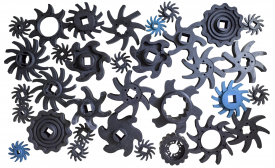What is rubber?

That is a good question – what is rubber? We have all seen the famous photos of rubber trees with streams of white sap oozing from cuts in their bark, and natural rubber is indeed extracted from this white sap. But as well as natural rubber, there is also synthetic rubber, which is now more common than natural rubber. Synthetic rubber is made from crude oil and is not a natural product. There are also some differences between the properties of synthetic rubber and those of natural rubber.
Rubber is a resilient, elastic polymer, which is used in products as diverse as car and bicycle tyres, buffer blocks, seals, mattresses, babies’ dummies, and many other things.
Natural rubber (NR)
Natural rubber is a very special polymer, originating as it does from nature. The rubber trees (Hevea brasiliensis) are tapped every day, and approximately 30% of the sap collected consists of rubber (called latex). Latex is a milky fluid; a mixture of proteins and water-saturated rubber particles.
Read more about the history of rubber here.
Synthetic rubber
Synthetic rubber is made from components of crude oil, bonded together by means of a chemical process to form a synthetic polymer (rubber). It was developed in the US as an alternative to natural rubber when that commodity became scarce.
One of the best known types of synthetic rubber is SBR rubber, which is used for the production of car tyres, among other things. Other synthetic rubber polymers include: EPDM, NBR and FKM (Viton).
Additives
Chemical substances (additives) are added during the blending process to ensure that the eventual rubber produced has the specific properties required. These substances are added to both natural and synthetic rubber.
Here are some examples of additives:
Vulcanising agent: sulphur and other vulcanising products ensure that the rubber can be vulcanised (baked) into a truly resilient and elastic end product. This vulcanising (baking) causes an irreversible chemical process which also prevents rubber from melting.
Fillers: soot and silica are two examples of fillers; these enhance the firmness of the rubber.
Colouring agents: these give the rubber a certain colour.
Preservatives: these protect the eventual rubber product from ageing and ozone.
Plasticizers: these are oily substances which make the rubber end product softer.
Would you like to know more about rubber?
Many rubber products are manufactured every day at the production sites of RIS Rubber in Lelystad and in Bulgaria. If you are looking for a rubber product, don’t hesitate to contact us. No matter what rubber product you require, we can produce it for you.
The demand comes from your end; we have the knowhow and expertise.
As for the solution… we create it together.
Let’s make things together!

